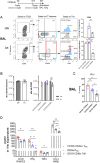Differential predictive value of resident memory CD8+T cell subpopulations in patients with non-small-cell lung cancer treated by immunotherapy
- PMID: 39631852
- PMCID: PMC11624836
- DOI: 10.1136/jitc-2024-009440
Differential predictive value of resident memory CD8+T cell subpopulations in patients with non-small-cell lung cancer treated by immunotherapy
Abstract
Background: A high density of resident memory T cells (TRM) in tumors correlates with improved clinical outcomes in immunotherapy-treated patients. In most clinical studies, TRM are defined by the CD103 marker. However, it is clearly established that not all TRM express CD103, but can be defined by other markers (CD49a, CD69, etc). The frequency of these subpopulations of TRM expressing or not CD103 varies according to the location of the cancer. Little is known about their functionality and their predictive impact on response to immunotherapy. In preclinical models, only some subpopulations of TRM are associated with cancer vaccine efficacy.
Methods: Multiparametric cytometry analyses were used to demonstrate the presence of TRM subpopulations in the lung in mice after vaccination and in fresh ex vivo human non-small cell lung cancer (NSCLC). An analysis of the T-cell repertoire of these TRM was conducted to search for their relationships. Multiplex immunofluorescence techniques were used to quantify intratumor infiltration of TRM subpopulations in two cohorts of patients with NSCLC. The impact on the clinical outcome of the TRM tumor infiltration was also investigated.
Results: We identified two main TRM subpopulations in tumor-infiltrating lymphocytes derived from patients with NSCLC: one co-expressing CD103 and CD49a (double positive (DP)), and the other expressing only CD49a (simple positive (SP)); both exhibiting additional TRM surface markers like CD69. Despite higher expression of inhibitory receptors, DP TRM exhibited greater functionality compared with SP TRM. Analysis of T-cell receptor (TCR) repertoire and expression of the stemness marker TCF1 revealed shared TCRs between populations, with the SP subset appearing more progenitor-like phenotype. In the training cohort, PD-L1 (Programmed Death-Ligand 1) and TCF1+CD8+T cells predict response to anti-PD-1. In patient with NSCLC validation cohorts, only DP TRM predicted PD-1 blockade response. Multivariate analysis, including various biomarkers associated with responses to anti-PD-(L)1, such as total CD8, TCF1+CD8+T cells, and PD-L1, showed that only intratumoral infiltration by DP TRM remained significant.
Conclusions: This study highlights the non-equivalence of TRM subpopulations. The population of TRM co-expressing CD103 and CD49a appears to be the most functional and has the most significant capacity for predicting response to immunotherapy in multivariate analysis in patients with NSCLC.
Keywords: Lung Cancer; T cell; Tumor microenvironment - TME.
© Author(s) (or their employer(s)) 2024. Re-use permitted under CC BY-NC. No commercial re-use. See rights and permissions. Published by BMJ.
Conflict of interest statement
Competing interests: None declared.
Figures






References
MeSH terms
Substances
LinkOut - more resources
Full Text Sources
Medical
Molecular Biology Databases
Research Materials
